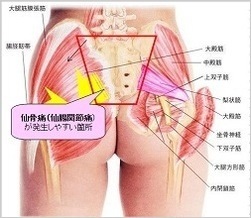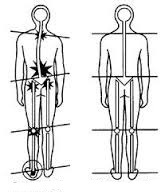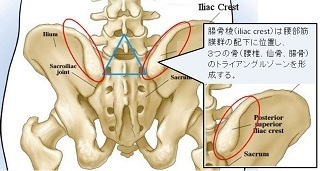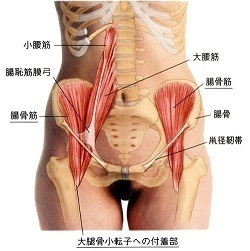"Sacrum pain (sacroiliac joint pain)" that is not low back pain.
Overview of Sacrum Pain / Sacroiliac Joint Pain
Abstract

As shown in the figure, sacrum is located too low in "lower back" and too central in "buttocks".
For this reason, I classify pain in this position as "sacrum pain (sacroiliac joint pain)".
The reason why many patients are diagnosed with "low back pain" even though they suffer from this pain is because the characteristics of sacrum (sacroiliac joint) are not fully recognized and it is confused with other symptoms.
If you have any of the following symptoms, you need to take care of. There have been cases where the symptoms actually cause with pain in sacrum.
- Pain in muscles of buttocks (around sacrum)
- Pain in both lower back and hip joint
- Pain when lying on your back or side
- Pain after sitting in a chair for a long time
- Pain at the start of activities such as turning over or bending forward
Since it is very difficult to diagnose with MRI, CT, and other imaging techniques, the criteria for judgment are the location of pain, movement that triggers it, and past symptoms.
Discussion Reason
There are many triggers that cause sacroiliac joint pain, whether they are nerves, muscles, or other.
Even if the factors are narrowed down, it is not possible to eliminate the pain by focusing only on nerves. Simply put, this is because we prioritize nerve control that causes pain and leave physical processes that led to the pain behind.
The mainstream policy is to temporarily suppress the pain and try to solve it with exercise therapy, which ultimately depends on patient's own efforts.
1-1 Nerves be pressured
Lower limb are dependent on the nerves in lumbar vertebrae and the nerves in the posterior sacral foramen, respectively.
Since important bundles of nerves exit from sacral as well as lumbar vertebrae, severe damage to pelvis (bruises, fractures, etc.) in an accident can result in serious permanent disabilities in lower limbs.
If there is stiffness or strong tension in buttock, the nerves in sacral foramen may be compressed and develop into pain.
If buttock is too loose, it may become sensitive to external stimuli, causing discomfort and pain.
1-2 Impact from Contact zone
Sacrum has center of gravity and its in center of pelvis, it directly receives the weight of upper body and the impact of two legs.
Quadrupedal animals are able to distribute the burden of jumping, landing, sudden stop and start at four points, but bipedal humans cannot adequately distribute it.
For this reason, human sacrum and sacroiliac joints are more developed than those of other animals, and have evolved into special joints that have the property of dampening action and move only in millimeters.
If sacroiliac joint is distorted, it cannot act adequately due to the impact of walking or the burden of carrying loads. As a result, it increases the risk of pain and discomfort.
1-3 Triangle zone of Lumbar fascia group
Under the control of lumbar fascia group, 3 important bones in trunk, lumbar vertebrae, iliac crest and sacrum, balance each other in a triangular position.
This triangular zone crosses, absorbs, and disperses impact and burden on each bone.
However, if this triangle is not balanced due to misalignment of trunk or distortion of centerline, or if muscles related to lumbar fascial group (abdominals, erector spinae, piriformis, etc.) deteriorate, the triangle zone will not be able to function properly.
In particular, when iliac crest muscles is stiffened near the lumbar vertebrae and sacrum, it loses its concavity and remains flat or raised. (See figure).
When lumbar fascial group becomes stiff, the entire pelvis becomes less flexible, and impacts from left, right, upper and lower sides are applied directly to sacroiliac joint.
1-4 Hip joint pain at the same time
Because hip joint has many areas that move by linkage (such as groin, pronator, iliac crest, etc.), movement can irritate muscle tissue and ligaments around sacroiliac joint. Pain may be felt in iliopsoas muscle that connects upper iliac crest to lesser trochanter of femur.
There have been cases of hip joint pain along with sacroiliac pain, and cases where sacroiliac pain disappeared but hip joint pain remained.
Due to pelvis is connected to muscles and ligaments just like a Möbius loop, it is difficult for patient to know the exact location of pain.
However, it is important to note that sacroiliac joint pain may occur along with hip joint disorders (injury, surgery, etc.).
It is possible that the symptoms have moved to next stage, and it is difficult to see improvement only with burden reduction such as S.O.T.
Repeated rehabilitation (simple and mild exercises) is necessary to strengthen ligaments and muscles around hip joint.
[TOPICS] Sacral Ossification
Sacrum is made up of five sacral vertebrae that are fused together. Sacrum has many ossification centers that form sacral vertebrae, most of which fuse by the age of 20, but some do not fuse until middle age or later.
Therefore, it is also a bone that varies greatly from person to person. In addition, the center of gravity is located in sacrum, which is a bone that cannot be ignored in stabilizing balance. However, for the reasons mentioned above, diet, lifestyle, and posture from childhood to adulthood greatly affect the formation of bone, and as a result, there are cases of imbalance.
What is the ossification center?
This is the point at which ossification begins to occur. This point is also called the ossification point.
Discussion Timing
Recording the timing of pain onset and finding similarities and differences with other patients is an important process in clinical data.
For example, if the onset tends to be non-age-related, we can notice inconsistencies in the age cause.
If it is related to a specific disease or disorder, we can affirm the influence of internal organs. The accumulated cases will be developed into factors and measures.
2-1 During pregnancy and childbirth (postpartum) period
In some cases, the pain occurs from pregnancy to childbirth or after childbirth, and the discomfort remains even several years after.
Pelvis, which supports fetus, moves during pregnancy and opens to the limit during childbirth, which may cause direct burden and trigger pain.
As a preventive measure, pelvic belt is used to return pelvic opening at an early stage, but there is not enough evidence to support the use of it.
Pelvis is not something that can be returned by applying pressure, but the angle and breathing (timing) with muscles are important. There is no point in doing so without taking these into consideration.
Midwifery clinics and hospitals vary in their approach, and those that don't place much emphasis on it will only recommend that you use it on your own, but will not teach you how to wrap it.
In fact, many women suffer from pain after childbirth in spite of preventive measures taken.
2-2 Start to feel Wobbles of pelvis or Uneasy walking
People with sacroiliac joint pain may complain of a "wobbly lower back" or "uncomfortable walking". Generally speaking, it is caused by weakness of abdominal and back muscles and the muscles around waist, but there is more to it than that.
Sacroiliac pain can also occur in people with healthy legs who adopt a habit of physical exercise every day or who make it a habit to walk.
| ・Worn soles, left and right distortions |
| Shoes are a indicator of your balance. The more soles of shoes are worn down, the more there is a wobble in "penguin walk". On the left and right sides of shoe, the foot with weaker step is more likely to collapse, and shoe is likely to draw to one aside shape. Even if bones are the same length, the length of legs can vary depending on the condition of muscles and joints. On the other hand, the longer legs tend to float, resulting in an inconsistent step. |
| ・Delayed response of muscles |
| When muscles of back and buttocks have accumulated years of body wastes, there is a delay in the onset of movement (Time lag). The image in your mind is half a tempo behind the actual movement. It is easy to blame age for stumbling over steps when you should have stepped over them, or dropping things, but this may not be the case. |
2-3 Misidentify coccyx pain
If you are experiencing "coccyx pain", it may be difficult to distinguish the position of sacrum and coccyx and they may be mixed up.
You need to take a different approach to sacroiliac joint, such as focusing on loosen up coccyx muscles.
| Examples of symptoms |
| ・Tingling pain from the tip of sacrum ・Pain at the contact surface when sitting or lying ・Discomfort mainly in lower back when walking |
The roles of coccyx and sacrum are different, and although coccyx is already degenerated, they are related in the following ways.
- Coccyx is related to human balance, such as quadrupeds use their tails to maintain balance.
- Coccyx is located at the tip of sacrum, so it is influenced by it.
- Muscles around coccyx muscles are linked to sacrum.
2-4 Chain of Past or Present symptoms
Past muscles injury and internal organs disability may be related to sacroiliac joint pain.
However, please note that there is still a lot of uncertainty about those.
| ・Linkage with symptoms in lower back and hip joint |
| If you have experienced hernia, sciatica, acute low back pain, chronic low back pain, or hip joint pain in the past, or if you are still suffering from them, you are at a higher risk of developing sacroiliac pain. If you are experiencing symptoms in lower back, sacroiliac joint has been burden on for years or decades due to the distortion of body balance. In addition, repeated sitting and walking activities while sheltering from hip joint and lower back pain can add various burdens, large and small, to sacroiliac joints, further increasing the risk of developing sacroiliac pain. Lower back that has been troubled in the past (even if there are no symptoms now) is not completely free of risk. Once the muscles and tendons have been damaged in some way, they will never fully return. |
| ・Linkage with past injuries |
| njuries caused by car accidents, sports injuries, etc. may lead to sacroiliac joint pain, especially if the injury is more than a fracture or if there is still tendon damage. However, verification of cases is underway, but further research is still needed. |
| ・Linkage with past serious illness |
| In the manual of S.O.T, it is stated that the risk of sacroiliac joint pain increases depending on patient's past illness. In fact, the presence or absence of past major illnesses is a matter that cannot be ignored, especially cancer. On the other hand, there are cases where the pain of disease is perceived as sacroiliac joint pain, making it difficult to classify. In addition to diseases in pelvic area (intestines, uterus, ovaries, etc.), there is a possibility that diseases in lungs and heart, which are far away from the lumbar area, are also related. However, verification of cases is underway, but further research is still needed. |
2-5 Drinking habits
It has been confirmed that women who have a habit of drinking alcohol daily or endlessly at one time, or who drink the same amount as men, (1) have an increased risk of developing sacroiliac joint pain, and (2) have difficulty improving it.
This is particularly noticeable in women who drinking, and is a concern that cannot be ignored.
Alcohol increases the risk of arthralgia, and when it appears near sacroiliac joint, it is more likely to cause symptoms similar to arthralgia. In addition, women have a smaller drinking capacity than men, which further increases the risk.
If limiting alcohol consumption increases the possibility of improving sacroiliac joint pain, then you should actively try to limit it as a "measure for sacroiliac joint pain".
However, habitual drinkers tend to look away from the problems caused by alcohol, so they cannot face the causal relationship between alcohol and arthralgia, which seems to complicate the cause of problem.
Discussion Balance
It's easy to just say that "Physical distortion leads to pain", but it's difficult to substantiate the verification.
4-1 Body distortion and sacroiliac joint pain

As the body distortion approaches CAT3 (Category Three), the risk of sacroiliac joint pain increases.
・Body Distortion Category
| classification | progress | detail |
| Normal | basis | It is a state where there is almost no distortion of your body. This state is bases. |
 | ||
| CAT1 | Early | This is the initial state of balance distortion. Tilt of either the front or back can be seen. |
 | ||
| CAT2 | Mid | The distortion is more advanced than CAT1. There is a tilt from side to side and distortion from face to toes. |
 | ||
| CAT3 | Late | This is a more advanced state of distortion than CAT2. Pelvic torsion, joint stiffening, and other strains occur. |
・Body distortion and judgment
As the distortion of your balance strongly, your skeleton will show some signs.
The shape of face, the height of left and right shoulders, and the twist of pelvis are all affected in various ways.
In particular, sacroiliac joint, which is close to the center of gravity, cannot fully alleviate the impact from above, below, left and right, and becomes heavily burdened.
As the risk of sacroiliac joint pain increases as the distortion progresses, it is necessary to reduce the burden on sacroiliac joint by S.O.T along with skeletal adjustment.
There are various causes for the advancement of the distortion category. They range from fatigue accumulated over years to past injuries and diseases.
Conclusions
Sacrum pain (sacroiliac joint pain) is difficult to determine due to the mixture of low back pain, buttock pain, and sciatica, which does not match the symptoms patient complains of.
However, it is possible to approach the problem in an appropriate manner by considering trigger factors, timing of onset, and body distortions from a multifaceted perspective.
The elucidation of sacroiliac joint pain is still in the developmental stage, and it is an area that requires further clinical studies.


